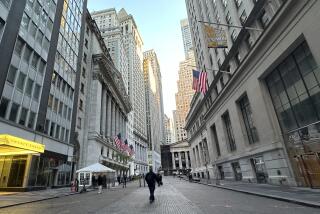Index Points to More Economic Growth Ahead
- Share via
WASHINGTON — The prospects for continued economic growth improved in July as the Commerce Department on Tuesday reported the sixth consecutive monthly increase in its index of leading indicators.
The rise of 0.5% in the government’s chief barometer of future economic activity, led by a bull market on Wall Street and indications of a large backlog of manufacturing orders, follows a revised 1% increase in June.
“The economy is shifting gears, picking up speed and becoming better balanced,” said Allen Sinai, chief economist at Shearson Lehman Bros., a top New York investment firm. “The economy is being driven forward by consumer spending and industrial output, which means that manufacturing, mining and agriculture are all coming strongly back on stream.”
The six months of uninterrupted increases in the leading indicators was the best showing since a similar run in late 1985 and early 1986.
Although reports on actual economic activity for August have not been completed, they are expected to show continued growth, allowing the economy to equal the peacetime record of 58 months of expansion set in 1975-80. In Santa Barbara, White House spokesman Marlin Fitzwater marched into his daily press briefing with a bottle of Champagne marked “58 months” to celebrate the mark.
“Let’s hear it!” Fitzwater shouted, holding aloft the French Champagne. “Reaganomics is working!”
Mickey Levy, chief economist at Fidelity Bank in Philadelphia, said that the economic gains of early summer are all “pointing to stronger growth for the second half of the year. We’re keeping a lookout for early warning signals that could lead to weakness, but right now it looks like the economy should forge ahead for at least another year.”
Negative Sign
About the only negative sign on the horizon is weakness in construction spending, which slumped in July for the second month in a row. It was held down by a dip in construction of apartment buildings and office buildings because of widespread overbuilding and tax law changes. Building activity fell 0.2% to a seasonally adjusted annual rate of $391.8 billion after a revised drop of 1.3% in June.
Factory orders were also down by 0.2% to a seasonally adjusted annual rate of $204.9 billion, primarily because of a plunge in the volatile defense goods category and weak auto sales. But it was the first dip since January and it followed a gain revised upward of 2% in June. Analysts were also cheered by the sharp 5.1% jump in orders for non-defense capital goods, a key indicator of business investment plans.
Moreover, another rise in business backlogs suggested that the economic expansion still has plenty of life left. Even relatively cautious analysts now are predicting that moderate growth could continue through the end of the 1980s.
‘For Many Years’
“My own personal view is that we can go on like this for many years,” said Lawrence Chimerine, president of Wharton Econometrics, a forecasting firm in Bala Cynwyd, Pa. “This is slower growth than we had in the 1950s and 1960s but because of the slower growth, we may not have a traditional recession for some time.”
The optimism was not dimmed by the sharp drop of the stock market Tuesday. The Dow Jones average of 30 industrials dropped 51.98 to 2,610.97. (Details in Business.)
The index of leading indicators, which reached a level of 191.8 over its 1967 base of 100, is composed of 11 different reports that are considered bellwethers of the economy’s future. In July, four of them rose sharply, three dipped, two remained the same and the final two will not be available for a month.
Slow Deliveries
Most important was the finding that 62% of all companies said that vendors were slower in delivering goods, an indication that there is a strong demand for business.
The positive factors, including an increase in price-sensitive materials and a rise in orders for plant and equipment, outweighed the drop in new orders for manufactured consumer goods, a decline in building permits and a slight shrinkage of the money supply.
The average workweek and average new claims for unemployment insurance showed no change, while information was unavailable on changes of inventories and credit.
The next important clue to the economy’s performance will be disclosed on Friday, when the Labor Department reports on employment in August.
More to Read
Inside the business of entertainment
The Wide Shot brings you news, analysis and insights on everything from streaming wars to production — and what it all means for the future.
You may occasionally receive promotional content from the Los Angeles Times.










